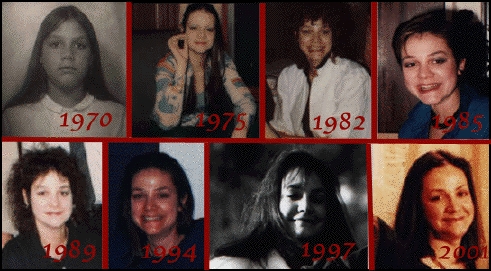Family history has been on my mind of late. My sister Robin has been doing quite a bit of genealogical research, as well as scanning old photos and artifacts. We have fragments of family-history Web sites online, but I’m getting ready for a major revamp, re-design, and consolidation.
The author of the blog Shades of the Departed (I think the author is KIM O’NEILL) has provided some great tips on ways to use photos to convey family history. O’Neill uses these techniques in making custom heirloom books. Here’s a brief summary of ideas from her excellent and beautifully illustrated blog post:
-
- Repeating photos: “Take photos from the same event or time period at regular intervals, and simply put them next to each other.” The example O’Neill uses is a series of photos of her brother and her sitting on Santa’s lap through the years. I could create a similar montage with the first-day-of-school photos I took of my two children each year — posed in the same place on our front porch. Another example is this series, below, of my best friend, Liz, and her hairstyles through the years.
-
 Photo In A Photo: O’Neill shows a couple of examples of this concept. In one, the subject in a daguerreotype holds a daguerreotype of someone else. In the other, a grandmother holds a portrait of herself when she was younger. My example could come from any one of the photos shot of family gatherings in my grandparents’ dining room. The background in any of these shots is a large gallery of black and white family photos (see red circle in the photo below).
Photo In A Photo: O’Neill shows a couple of examples of this concept. In one, the subject in a daguerreotype holds a daguerreotype of someone else. In the other, a grandmother holds a portrait of herself when she was younger. My example could come from any one of the photos shot of family gatherings in my grandparents’ dining room. The background in any of these shots is a large gallery of black and white family photos (see red circle in the photo below).- Photos with Words. Captions are the obvious way, O’Neill says, but she has created numerous images such as the one of “Anna” in which the “photo her husband James carried in his pocket of Anna while he served in World War II.” O’Neill says she “overlaid a beautiful love letter James wrote to Anna, and included a caption at the bottom of the page explaining James had carried this photo in his pocket.” I’m sure I have a few letters I could do something similar with. O’Neill also uses call-out text. “I take a sentence or two of the text,” she says, “enlarge it, and place it on top of, or alongside, a photo. This is a great way to connect the story and the photo, and also provides a quick visual first-read when there is lots of text on a page.”

